Schooldays
Did you go to school in Walthamstow? Want to see pictures?
Pictures and stories here!


This page is our modest tribute to all those who, during WW2, risked or even gave their own life to protect, assist and soothe their fellow citizens in such dramatic circumstances. How many civilians were saved by these brave men & women we shall never know exactly...
You are welcome to send in any personal stories & pictures. [Email Daniel]
Exceptional footage: V1 Bomb Damage Walthamstow 1944 in the British Pathé archives
Hi Daniel,
I was going through some old photos and came across this one which is a copy of a Guardian article some years ago. My Dad (Bill Johnson) is seated front row far left in the white sash (he was a drummer). He had joined the Navy when called up but was thrown out some months later when they realised he only had one good eye - the other one had been badly damaged in a catapult accident when he was about 13.
Steve JOHNSON Private Reply Public Reply
Thanks, Daniel, for responding to my daughter’s request. I had wanted to post his photo before Nov. 11th but had no luck with the war memorial site.
Edward Benjamin Durnford Brunton, known as “Ben”, was the son of Kathleen Brabazon Durnford and Charles Brunton. Kathleen and my great-grandmother, Georgiana Durnford Griffenhoofe, were sisters. Ben was born 1893, and died ca 13 Nov. 1916, 23 years old, apparently at the battle of the Somme. He was a 2nd Lt., married to a Mabel Flowerdew. His photo, from my great-grandmother’s book, looks like it may have been taken from a group photo as someone else’s arm is in the photo.
Whatever help you can give to get this message posted onto the memorial site would be great.
Thanks!
Georgianna (Georgie) BIRCH THURBER Private Reply Public Reply
Hi, I am not sure where I found this website: The War over Walthamstow 1939-1945 Maybe it was in W'stow Memories and if so, I apologise. If not, I am sure others would like to see it. I wish it had been available when I was at school. Would have been amazing to walk the streets & imagine the bombs dropping. Steve Read. W'stow 1949 - 1984.
Steve READ
Private Reply
Public Reply
Hi Daniel,
Bill Bayliss gave me your email address. I have been going through my dad's possessions and found some photo's of the Bawn Reunion Event 1945 (visit to Bury St Edmunds 1995). My dad (Stan Robinson) went to the reunion, but as none of the photos contain my dad I have no use for them. Would you or do you know of any one who might like them? They are hard copies so would need to send them to you, which I am quite happy to do. It would seem a shame to put them in the bin.
.jpg)
.jpg)
Stan Robinson is 1st on right in picture at the top
.jpg)
.jpg)
.jpg)
.jpg)
.jpg)
.jpg)
.jpg)
.jpg)
.jpg)
.jpg)
(All pictures © 1995 Studio Five, Thetford & Brandon, UK - http://www.studio-five.co.uk - By kind permission)
Love the Walthamstow Memories website, been doing family tree and found that most of my family have lived there at some point.
Debbie CLARK
Private Reply
Public Reply
10 Nov 2010: Hi Daniel, John I have some photos of my father Sgt O.G Freeman MM with my mother and a group of people - I belive it was the first showing of the film "For theirs the Glory" shown at the Granada Walthamstow in 1947 its the story of the battle of Arnhem. I belive the Granada manager at that time was also in the Airbourne forces during the war. I can download and send them to you, but where do I send them to? many thanks.
Brian FREEMAN
Private Reply
Public Reply
ca. 1947 - "Their is the Glory" (picture kindly provided by Brian Freeman)
"FOR THEIRS IS THE GLORY" - The true story of the battle of Arnhem the actors were the actual soldiers that survived that battle. In 1946 they went back to Holland to reenact their fight against the backdrop and carnage that was Arnhem. In 1947 the Granada Walthamstow showed this film to large audiences for two weeks with some of the soldiers welcomed on stage. My father was one of them: Sgt George Freeman(MM) from Jewel Road Walthamstow.

Home Guard Memorabilia - ca. 1940 (repro kits possibly available on eBay)
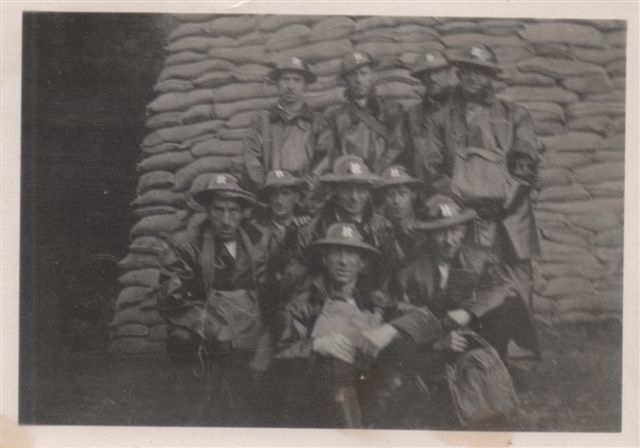
Are these men ARP personnel? They appear to be so, yet they don't have ARP on their tin hats...and the logo on their hats looks something like a 'K'. So this might not show Walthamstow personnel. My mother told me that when the city of London was having a huge number of very destructive bombing raids, she, her ARP crew and other Walthamstow crews would be despatched to help out in the city. I wonder if this might show city ARP personnel from somewhere like Kennington or Kensington? Alternatively, could it show Walthamstow personnel helping out in the city and wearing the local personnel's hats? Puzzling.
Colleen
Hello, the photo of the "ARP" with "K"s on thier tin hats on, are definitely ARP gang, the gent second in second row is my lovely grandfather Bill Hattersley.
Regards.
Julie MACLEOD Private Reply Public Reply
NFS (National Fire Service) - Created during 1941.
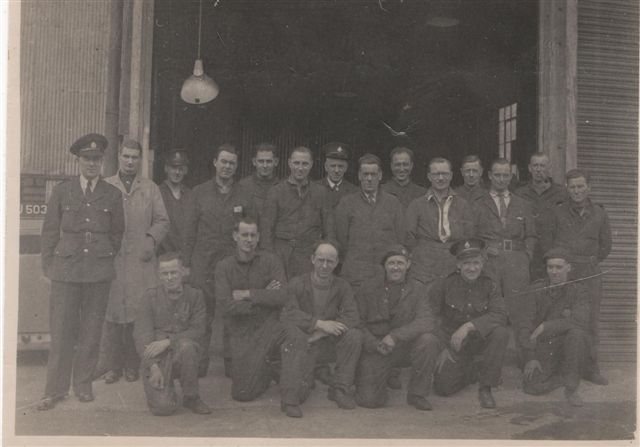
NFS, believed of Walthamstow, taken at Barnet workshop 1945 - (picture kindly provided by Colleen Morrison)
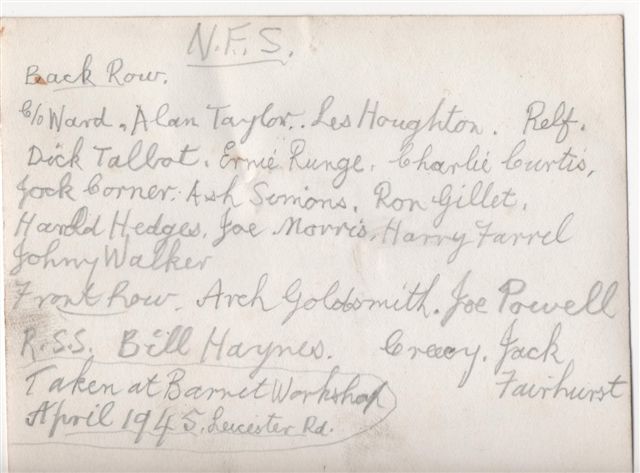
NFS, taken at Barnet workshop 1945 (reverse) - (picture kindly provided by Colleen Morrison)
03 Oct 2010 - (Public reply): Colleen, Was so glad to hear someone else praise the ARP but, unfortunately, the photo you shew was not the uniforms of the ARP but of firefighters whose uniform was entirely different. The ARP never had silver buttons - the Verulam Avenue ARP post wore either black overalls or black jackets to the waist and trews.
Jean BROWN
Private Reply
Public Reply
02 Oct 2010 - ARP/NFS in W'stow: Who were these courageous war time fire fighters, Daniel? I don't know, I don't have their names. One thing is certain, with over 300 bombing raids on Walthamstow during World War II, they all risked their lives many times to contain the reusulting fires and to release people buried under debris.
That young woman could almost be my mother, she had very similar looks and hair style, though my mother was even prettier and had better legs (!!)
Colleen

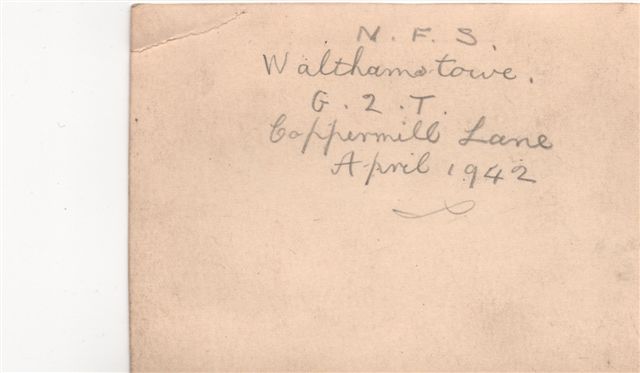
This following is my public reply to Jean (26 Sep 2010):
Thank you, Jean, for mentioning Britain's courageous ARP. How very brave they were, just ordinary people who'd lived uneventful lives before the war, yet they all became heroes during wartime, every one of them.
The tragic, 60,000 civilian deaths that occurred in Britain during World War II, most of which occurred during German air raids or rocket attacks, would certainly have been substantially increased had it not been for the courageous and extraordinary heroism of millions of ordinary people who volunteered to serve their countrymen and women in extraordinary ways in the ARP and NFS.
Here in my study I have an ARP survivor of the blitz: an original ARP medicine cabinet which I use to hold my writing utensils. It's a white painted, wooden cabinet, some 18" wide by about 12" tall and, say, 8" in depth, with the distinctive, scarlet 'ARP' logo picked out in raised, fretworked lettering on the front. The entire front of the cabinet is a hinged lid which lifts upward on brass hinges and inside are two shelves. What would the contents of this cabinet have been during the war, I wonder and would it have been an ARP station medicine cabinet, or would it have travelled around in the ARP's ambulances?
It's poignant memento for me which never fails to bring a lump to my throat when I open it, because, from the age of just 19, as an innocent young girl with no experience of life, my brave mother, Kathie Bryan, drove one of those ARP ambulances. At times, day after day, week in, week out, mum and all of the other ARP heroes had to cope with unthinkable horrors and tragedies.
My mother lived with her parents, William (Bill) and Mary Bryan and her three brothers, Ronnie, Charlie and little Leslie in Millfield Avenue, Walthamstow. So she was based in the nearest ARP station, at Roger Ascham School on the Billet Road.
On the 60th anniversary of VE Day, after my beloved mother had long gone to join the angels, my dear uncle Les and I returned to Walthamstow to celebrate our family's survival and to reminisce about our family and the war. I was a baby boomer, born years after the war, so have no memories of wartime, only of the stories my family told of their lives during the war.
I parked my car outside Roger Ascham School and turned to look at my uncle Les in the passenger seat: he sat with tears in his eyes, staring into the hazy middle distance of 60 years previously.
"I can see it as if it was yesterday", Les said, sighing heavily, "your mother driving out of the gates in front of that yard, never knowing what nightmare she might have to deal with. What her generation had to do to survive, it's beyond comprehension these days. I remember one morning she came home exhausted but couldn't sleep and she kept being sick. A double decker bus had taken a direct hit in the rush hour, outside the Standard pub, Kathie had been trying to help save those who could be saved and transporting the injured, then she had to go back for the bodies, what was left of them. One of her friends had been decapitated...it was weeks before they found his head."
Les and I went on to Millfield Avenue where we found a VE Day street party: 60 years after the war children were playing the same old games that their parents had played on that same street. That took me back to the street parties I'd attended there as a child, years after the war.
Les told me that he used to visit the ARP station when mum was on duty, he was just a young boy then. The ARP and other emergency services were given early warning of impending air raids and Les recalled my mother taking him aside on a few occasions during these visits and telling him to run home as fast as he could to tell my grandmother to get to the shelter - quickly!: "You mustn't stop for anything, Les, promise me!", she'd say.
"I'd get home and shout, 'get to the shelter, there's an air raid coming!' Dad would always say, 'I'm not leaving, I'm stopping 'ere, I'm sleeping in me own bed: Hitler's not getting me down that bl**dy shelter', and off he'd go, up the wooden hills clutching his nightly bottle of wallop to drink himself into blissful oblivion. Meanwhile, mum and I - we'd long given up trying to save dad from the bombs - we would be running up Carlton Road to the air raid shelter half way up.You know a rocket could have landed next door once dad had had his wallop and it wouldn't have woken him."
Every morning when we came out of the shelter mum would say: "Les, quick, run down the hill and come back and tell me if our house is still there and if dad's still alive!"
Colleen MORRISON
Private Reply
Public Reply
26 Sep 2010 : Hello Daniel, Being a regular reader of WM, I notice no mention has been made of the ARP during the war years, the following is knowledge which was partly obtained from a coach passenger during one of my trips from Norwich to London and bits from family stories:
There was an ARP post in St. Saviour's School playground, Verulam Avenue. As far as we worked out, this post was made up of an Electrician, A Waterboard employee, a Doctor, and Jim Ryder, who had the chemist shop opposite the Common Gate, Markhouse Road, and maybe others. The electrician had to restore all electricty, the Doctor attended the injured and the chemist supplied first aid equipment etc. etc.
Just one story stands out in my memory and that was when a bomb dropped in Lennox Road. The Verulam Avenue ARP post attended, first picking up pieces of human remains before getting down to their qualified jobs. After all main services were practically in working order, which took to the next day, the ARP then cleared the roadway so that traffic and pedestrians could go about their daily lives.
So these people were not just ARP Wardens who walked the streets shouting "Turn that light out", but brave men who had to cope with situations well outside their normal lives.
The coach passenger's relative (I believe) was Jim Ryder and my Dad was the electrician.
Jean BROWN
(née TRUMAN)
Private Reply
Public Reply
From Daniel: Dear Jean, nice to hear from you - many thanks for your message.
You are right: now that you make me think of it, I cannot recall the ARP being mentioned as it would deserve. Nor the Home Guard (your "Turn that light out!" inevitably made me think of "Dad's Army", a series that I enjoy almost every evening on DVD!).
I have a copy of "The War over Walthamstow" (reprint available at the Vestry House Museum), which gives a rather wide view of what the civil defence did and how it was organised. It is copyrighted material, but perhaps I may obtain permission to post some excerpts. However, I would much prefer to get 'first hand' stories - like in your case - from our visitors.
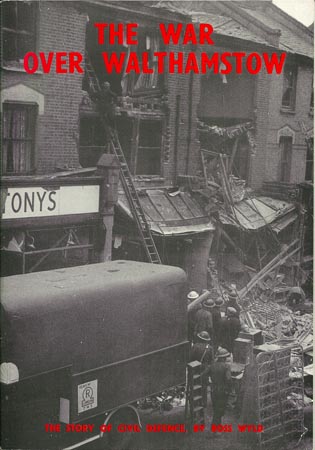
Front cover of The War over Walthamstow (© Vestry House Museum)